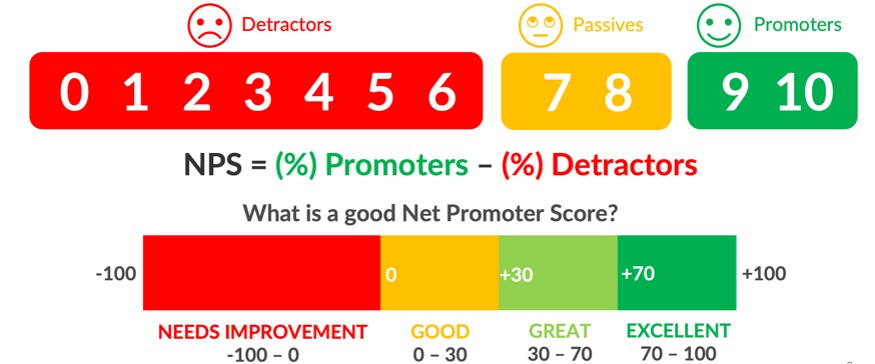Introduction
Implementing NPS survey best practices is essential in today’s fast-paced business world, where keeping tabs on customer loyalty and satisfaction is more important than ever. One of the best ways to do this is by conducting NPS surveys. The Net Promoter Score (NPS) is a simple yet powerful tool that can give you great insights into how your customers feel about your brand. In this blog, we’re going to break down some essential NPS survey best practices, from calculating the score to analysing the data and understanding what it all means.

Background to NPS
So, what’s the deal with NPS? This concept was introduced back in 2003 by Fred Reichheld, who wrote an article in the Harvard Business Review called “The One Number You Need to Grow.” When we conduct NPS surveys, we start by asking customers how likely they are to recommend our company to friends or colleagues on a scale of 0 to 10. Based on their responses, we sort them into three categories:
-
- Promoters (9-10): These are the customers who love us and are likely to spread the word.
-
- Passives (7-8): They’re satisfied but not super enthusiastic—these folks could easily switch to a competitor.
-
- Detractors (0-6): These customers aren’t happy and could damage our reputation with negative feedback.
To calculate the NPS, we subtract the percentage of detractors from the percentage of promoters. This leads us to the NPS score, and it’s that easy!
After the initial recommendation question, it’s crucial to follow up with an open-ended question like, “What’s the main reason for your score?” This allows us to gather qualitative feedback that can provide deeper insights into customer sentiment.
How to Calculate Your NPS Score
Calculating your NPS is straightforward, and following these NPS survey best practices will help ensure accuracy:
1. Send Out the Survey: Distribute your NPS survey via email, online forms, or even through your mobile app. Just make sure you’re reaching a good mix of customers.
2. Gather Responses: Once you have your responses, group them into those three categories: promoters, passives, and detractors.
3. Do the Maths:
- Promoter Percentage = (Number of Promoters / Total Responses) x 100
- Detractor Percentage = (Number of Detractors / Total Responses) x 100
4. Calculate the NPS: NPS = Promoter Percentage − Detractor Percentage
For example, if 60% of your respondents are promoters and 20% are detractors, your NPS would be 40. Simple as that!

Why NPS Survey Best Practices are Important
Understanding why NPS is important is a key part of NPS survey best practices. Here are some benefits:
- Gauge Customer Loyalty: NPS gives you a clear picture of how loyal your customers are and where you can improve.
- Predict Growth: Companies with high NPS scores often see better growth. Research shows that a 10-point increase in NPS can lead to a 2-3% boost in revenue. Who wouldn’t want that?
- Benchmark Against Competitors: NPS allows you to compare your performance with competitors and see where you stack up in your industry.
- Get Actionable Insights: By looking at open-ended responses, you can uncover valuable feedback that helps you enhance customer experience and loyalty.
Downsides and Risks of Using NPS
While NPS can be a powerful tool, it’s essential to be aware of some downsides and risks associated with its use:
- Oversimplification: NPS reduces customer sentiment to a single number, which can oversimplify complex emotions and experiences. Relying solely on NPS may prevent businesses from understanding the nuances of customer feedback.
- Misinterpretation: Without proper context, NPS scores can be misleading. A high score might lead to complacency, while a low score could trigger unnecessary panic. It’s crucial to combine NPS with other metrics for a fuller picture.
- Focus on Short-Term Trends: NPS can fluctuate based on recent experiences, which might not reflect long-term customer loyalty. Businesses should be cautious about making significant changes based solely on short-term NPS results.
- Response Bias: NPS surveys may attract more extreme responses (either positive or negative), as satisfied customers might not take the time to respond. This can skew results and may not represent the entire customer base accurately.
- Reluctance to Recommend Certain Products: Customers may hesitate to recommend specific products, even if satisfied, due to privacy concerns. For example, financial products often involve sensitive personal information, leading customers to prefer discretion over public endorsements. This reluctance can result in lower NPS scores in industries like finance and healthcare.
Collecting NPS Data Effectively: Best Practices
When it comes to collecting NPS data, following these NPS survey best practices can help:
- Online Surveys: Use platforms like SurveyMonkey, Typeform, or Alchemer to create and send out your NPS survey. This method is efficient and user-friendly.
- Email Campaigns: Slip the NPS question into customer feedback emails or post-purchase surveys to get insights from those who’ve recently interacted with your brand.
- Mobile Apps: If you have an app, integrate NPS surveys right into it for instant feedback after key interactions
- Telephone Surveys: Want a more personal touch? Consider conducting phone interviews, especially for your high-value customers. This can lead to some great insights!

Analysing NPS Data: Techniques and Strategies
Quantitative Analysis of NPS Scores: Best Practices
After collecting your NPS data, the first thing to do is analyse the quantitative score. Here are some NPS survey best practices for analysis:
-
- Track Trends Over Time: Keep an eye on your NPS over time to spot trends and see how changes impact your score.
-
- Segment Analysis: Break down NPS scores by different customer segments—think demographics or purchase history—to find out who’s loving you and who’s not.
Text Analytics for Open-Ended Responses in NPS Surveys
Don’t forget about those open-ended responses! After asking for their score, analysing the qualitative feedback provides invaluable insights. Here’s how to tackle it:
-
- Sentiment Analysis: Figure out if the feedback is positive, negative, or neutral. This helps you grasp overall customer sentiment.
-
- Identify Common Themes: Look for recurring feedback that points to strengths and weaknesses in your offering. If a lot of customers mention long wait times, that’s a red flag to address.
Additional Questions to Enhance Your NPS Survey Best Practices
While the NPS question is the star of the show, adding a few more questions can provide deeper insights. Here are some NPS survey best practices for additional questions:
-
- Follow-Up Questions: Ask respondents why they gave their score. This can reveal specific issues or strengths.
-
- Customer Experience Questions: Get into the nitty-gritty of customer experience – ask about product quality, service, and pricing.
-
- Future Intentions: Questions like “What would encourage you to recommend us?” can lead to actionable insights for improvement.
Benchmarking Your NPS
Benchmarking your NPS against industry standards can help contextualise your results. Many companies report impressive NPS scores, indicating strong customer loyalty:
-
- Apple: Known for its stellar customer service and product quality, Apple often boasts an NPS of around 72.
-
- Netflix: With its user-friendly platform and personalised recommendations, Netflix typically sees an NPS of about 63.
-
- Amazon: Amazon consistently ranks high in customer satisfaction, with an NPS around 60.
These benchmarks give you a target to aim for and can inspire improvements in your customer experience.
Conclusion
Implementing NPS surveys is a fantastic way to measure customer loyalty and satisfaction. By getting familiar with the methodology, calculating the score, and analysing the data, you can gain valuable insights that drive improvements. With the right strategies in place, you can use NPS to boost customer experience, enhance loyalty, and ultimately propel your business forward.
Call to Action
Ready to level up your customer insights? Let’s chat about how we can help you design and implement effective NPS surveys tailored to your business needs. Together, we can understand your customers better and achieve sustainable growth!








